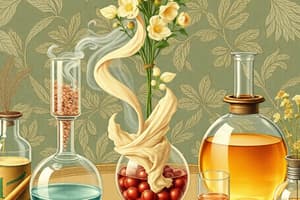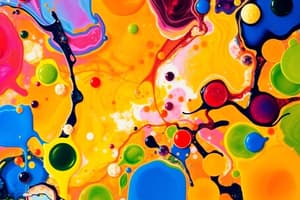Podcast
Questions and Answers
Which separation technique is most suitable for separating a solid-liquid mixture where the solid does not dissolve in the liquid?
Which separation technique is most suitable for separating a solid-liquid mixture where the solid does not dissolve in the liquid?
- Filtration (correct)
- Crystallization
- Decantation
- Evaporation
In the context of solutions, under what condition is a solution considered saturated?
In the context of solutions, under what condition is a solution considered saturated?
- When no more solvent can be added.
- When a solute dissolves rapidly.
- When a soluble solvent stops dissolving in a solution. (correct)
- When the solution is at its boiling point.
Which of the following is a direct application of magnetic separation?
Which of the following is a direct application of magnetic separation?
- Separating liquids with different boiling points.
- Separating sand from a solid mixture.
- Separating different sized particles in a mixture.
- Separating iron filings from sand. (correct)
What is the purpose of adding adsorbents during crystallization?
What is the purpose of adding adsorbents during crystallization?
What is the MOST important criteria when choosing a solvent for crystallization or recrystallization?
What is the MOST important criteria when choosing a solvent for crystallization or recrystallization?
In a scenario where one needs to separate a solid-gas immiscible mixture, which method is BEST to perform?
In a scenario where one needs to separate a solid-gas immiscible mixture, which method is BEST to perform?
For separating a liquid-liquid miscible mixture, like ethanol and water, what technique is MOST efficient?
For separating a liquid-liquid miscible mixture, like ethanol and water, what technique is MOST efficient?
What is the role of the condenser in distillation?
What is the role of the condenser in distillation?
What is chromatography based on?
What is chromatography based on?
In chromatography, what does a higher retention factor (Rf value) indicate about a compound?
In chromatography, what does a higher retention factor (Rf value) indicate about a compound?
Which of the following materials can be used as a stationary phase in chromatography?
Which of the following materials can be used as a stationary phase in chromatography?
What role does the mobile phase play in chromatography?
What role does the mobile phase play in chromatography?
What is the relationship between the number of carbon and hydrogen atoms in an organic compound and its polarity?
What is the relationship between the number of carbon and hydrogen atoms in an organic compound and its polarity?
If you have a mixture with an organic compound that decomposes close to its boiling point, what separation method might you use?
If you have a mixture with an organic compound that decomposes close to its boiling point, what separation method might you use?
Which technique relies on particle size?
Which technique relies on particle size?
Which type of mixture is differential extraction BEST suited for?
Which type of mixture is differential extraction BEST suited for?
Why is it important to filter the solution while it's still warm after adding adsorbent to help remove impurities in crystallization?
Why is it important to filter the solution while it's still warm after adding adsorbent to help remove impurities in crystallization?
After dissolving a solute in a hot solvent to make a saturated solution in a crystallization process, what is the purpose of letting the solution cool down slowly?
After dissolving a solute in a hot solvent to make a saturated solution in a crystallization process, what is the purpose of letting the solution cool down slowly?
What is the primary purpose of 'hand picking' as a separation method?
What is the primary purpose of 'hand picking' as a separation method?
For a liquid-gas mixture, which of the following separation techniques is MOST appropriate?
For a liquid-gas mixture, which of the following separation techniques is MOST appropriate?
Flashcards
Separation Technique
Separation Technique
Separation technique suitable for different phases of organic compounds.
Sieving
Sieving
Separation based on particle size; common for solid-solid mixtures.
Magnetic Separation
Magnetic Separation
Separation using a magnetic field. Useful when one component possesses magnetic properties.
Hand Picking
Hand Picking
Signup and view all the flashcards
Filtration
Filtration
Signup and view all the flashcards
Sedimentation
Sedimentation
Signup and view all the flashcards
Decantation
Decantation
Signup and view all the flashcards
Saturated Solution
Saturated Solution
Signup and view all the flashcards
Evaporation
Evaporation
Signup and view all the flashcards
Crystallization
Crystallization
Signup and view all the flashcards
Adsorbents
Adsorbents
Signup and view all the flashcards
Sublimation
Sublimation
Signup and view all the flashcards
Fractional Distillation
Fractional Distillation
Signup and view all the flashcards
Differential Extraction
Differential Extraction
Signup and view all the flashcards
Distillation
Distillation
Signup and view all the flashcards
Chromatography
Chromatography
Signup and view all the flashcards
Retention Factor (Rf)
Retention Factor (Rf)
Signup and view all the flashcards
Stationary Phase
Stationary Phase
Signup and view all the flashcards
Mobile Phase
Mobile Phase
Signup and view all the flashcards
Study Notes
- Liquid-liquid mixture
- Liquid-gas mixture
- Gas-gas mixture
Separation Techniques
- Suitable for different phases of organic compounds.
- Solid-solid mixture: sieving
- Magnetic seperation.
- Hand picking (depends on the particle size).
- Klinnowing
- Solid-liquid mixture:
- When a soluble solvent stops dissolving in a solvent, the solution is said to be saturated.
Separation Techniques
- Filtration
- Decantation
- Sedimentation
Apparatus for Filtration
- Receiving flask.
- Filter paper.
- Funnel.
- Filtration separates a solid-liquid immiscible mixture where the solute does not dissolve in the solvent.
- Filtration is the fastest way of separating a mixture.
- Decantation is for solid-liquid immiscible mixtures.
- Evaporation also can separate a solid-liquid mixture.
- Crystallization is suitable for separation of solid-liquid immiscible mixtures.
- Crystallization obtains a pure organic compound by dissolving the organic compound in a suitable solvent that dissolves the compound completely at elevated temperature but not at room temperature, followed by filtration.
- Adsorbents can remove contaminants or impurities.
- Use a suitable solvent during crystallization/recrystallization (a solvent that does not dissolve the compound completely at cold or room temperature but dissolves it when heated).
- Adsorbents can be silica, alumina, or activated charcoal.
Steps for Crystallization
- Obtain a suitable solvent.
- Heat the solution to dissolve the solute.
- Add adsorbent to help remove impurities while still heating.
- Filter while hot.
- Leave the solution to cool down at room temperature or in ice to allow crystals to grow.
- Filter the solution to obtain pure crystals.
- First filtration targets the filtrate, second targets the residue.
- Solid-gas mixture: sublimation or steam distillation.
- Steam distillation is good for gas immiscible mixture.
Liquid-Liquid Mixture
- Distillation
- Simple distillation.
- Fractional distillation.
- Vacuum distillation.
- Fractional distillation separates gas-gas mixtures.
- For separating liquid-liquid miscible mixtures:
- Steam distillation
- Simple distillation
- Vacuum distillation
- Chromatography
- For separating liquid-liquid immiscible mixture, differential extraction is used.
- A separating funnel is used during differential extraction.
- Distillation is the separation of organic mixtures based on their boiling points via heating.
Apparatus for Distillation
- Collecting flask.
- Condenser (converts gaseous vapor into liquid).
- Quick-fit flask.
- Chromatography separates organic compounds based on how well they are retained in the stationary phase under the influence of a mobile phase.
- Retention on a stationary phase is the Retention Factor.
- The obtained value/retention factor is known as the Rf value.
- Rf value for an organic compound is usually less than 1.
- Rf value = (Distance moved by the compound) / (Distance moved by the solvent).
- Stationary phase is a solid coated on / poured into a glass column/plate that retains the organic compound while it moves under the influence of a mobile phase.
- Materials used as stationary phases include silica gel, alumina, or cellulose.
- Mobile phase is a liquid or gaseous solvent that carries the organic compound through the stationary phase.
- Chromatography can be adsorption or partition types.
- Adsorption chromatography has subtypes: thin layer, preparative thin layer, and column.
- Partition chromatography can be divided into gas-liquid, liquid-liquid, paper chromatography, etc.
- Liquid-gas mixture processes: gravity, centrifugation, compression
- Any gas separation.
- Gas-gas mixture: fractional distillation
- When a mixture of organic compounds has one compound that decomposes close to its boiling point, use vacuum distillation.
- When the boiling point of the organic compound is less than 25°C, use simple distillation.
Studying That Suits You
Use AI to generate personalized quizzes and flashcards to suit your learning preferences.




